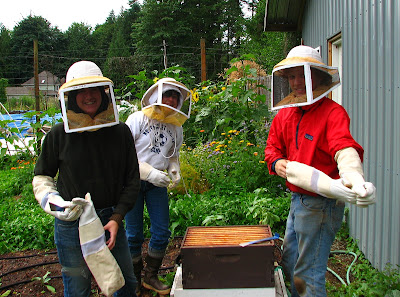Many thanks to farm hands Lauren and Kyle, as well as to the unnamed random visitor to the farm, for your help weeding Area Two this week. Much appreciated.
The new insect group examines the honey bee hive. This hive has had a hard time. It was thriving in February (see This Post ) but then all of March, April and May were unusually rainy and cold.
 During those cold, wet months the hive experienced mold, mildew, mites and ants. Meanwhile the queen seemed to be acting odd. The former bee group did what they could but in the end the hive started to falter.
During those cold, wet months the hive experienced mold, mildew, mites and ants. Meanwhile the queen seemed to be acting odd. The former bee group did what they could but in the end the hive started to falter.
Bad news for the honey bees, but on the bright side, the overall bee and pollinator
health seems to be thriving. Here are some pictures of the activity in the bee yard.
The flowers are swarming with insects. It is gratifying to see all the activity.
 |
| A bee says hello to the calendula. |


Here is a bee coming in for a landing on the phacelia.
 | |||
| Stumps. |
On Thursday I came in to find that several flowers had been harvested out of the bee yard. The cut stumps of phacelia and sunflower were the most obvious. In consulting with the farm manager I discovered that the PSA students had harvested the flowers based on a "misunderstanding." There was a rumor that these flowers had been offered up for sale at the campus farmers market. The harvest of a few flowers was not a huge deal but the trampling of the planted area was unacceptable.
 |
| "Too 'In Your Face'." - Farm Manag |
It was suggested to me by farm staff that I make a sign for the area to reduce the possibility of new misunderstandings. Here was my first sign.
 The farm manager objected to my first sign as being too
The farm manager objected to my first sign as being too"In your face", too big, and too close to the path. She
suggested a smaller sign, set
 back in the yard.
back in the yard.This was
my second sign. So far there have been no objections to this one.
Notice the soaker hoses in the above picture. I planted several herbs and ground cover in Area Three and am experimenting with different watering strategies.
Another challenge was the big wind storm we had on Thursday. I came in Friday to find all the sunflowers lopped over onto the dill. I ended up spending a good part of the day tying them up to supports. Since sunflowers track with the sun I tried not to tie them too high which might have impeded their movement.
 In the community garden next door a large sunflower also blew down and it snapped off at the base. None of the bee yard sunflowers broke and I think I was able to save most of them. I attribute their survival to the presence of the dill in front of them and also to the fact that I had done a heavy watering that day so their whole root mass leaned with them and helped prevent snapping off.
In the community garden next door a large sunflower also blew down and it snapped off at the base. None of the bee yard sunflowers broke and I think I was able to save most of them. I attribute their survival to the presence of the dill in front of them and also to the fact that I had done a heavy watering that day so their whole root mass leaned with them and helped prevent snapping off.





















